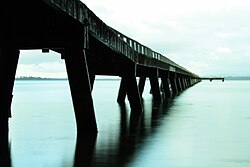Top Qs
Timeline
Chat
Perspective
Kauri Point
Rural settlement in the Bay of Plenty, New Zealand From Wikipedia, the free encyclopedia
Remove ads
Kauri Point is a rural settlement in the Western Bay of Plenty District and Bay of Plenty Region of New Zealand's North Island. It is on a headland on the eastern side of Tauranga Harbour, opposite Matakana Island.[6]
A coastal walkway through Kauri Point Historic Reserve connects Kauri Point to Ongare Point.[7] There are mature pōhutukawa trees and three pā sites in the reserve.[8][9] A 200 metre long wooden jetty, built after 1947, provides fishing access to the harbour.[10][11]
Dorothy Morris was a pioneer of the kiwifruit industry in New Zealand who she converted her dairy farm on Kauri Point Road to kiwifruit in the 1950s.[12]
George Vesey Stewart, who organised settlement of Katikati in the 1870s, initially planned for the town to be established at Kauri Point.[13] The settlement at Kauri Point did not eventuate until the 1970s.[14]
Remove ads
Demographics
Summarize
Perspective
Ōngare Point-Kauri Point is described by Statistics New Zealand as a rural settlement. Kauri Point covers 0.27 km2 (0.10 sq mi).[4] It is part of the larger Tahawai statistical area.[15]

Kauri Point had a population of 186 in the 2023 New Zealand census, an increase of 9 people (5.1%) since the 2018 census, and an increase of 15 people (8.8%) since the 2013 census. There were 87 males and 102 females in 75 dwellings.[17] 3.2% of people identified as LGBTIQ+. The median age was 50.2 years (compared with 38.1 years nationally). There were 39 people (21.0%) aged under 15 years, 21 (11.3%) aged 15 to 29, 81 (43.5%) aged 30 to 64, and 48 (25.8%) aged 65 or older.[5]
People could identify as more than one ethnicity. The results were 90.3% European (Pākehā), 17.7% Māori, 1.6% Pasifika, and 3.2% other, which includes people giving their ethnicity as "New Zealander". English was spoken by 98.4%, Māori by 4.8%, and other languages by 4.8%. No language could be spoken by 1.6% (e.g. too young to talk). The percentage of people born overseas was 14.5, compared with 28.8% nationally.[5]
Religious affiliations were 27.4% Christian. People who answered that they had no religion were 64.5%, and 8.1% of people did not answer the census question.[5]
Of those at least 15 years old, 30 (20.4%) people had a bachelor's or higher degree, 87 (59.2%) had a post-high school certificate or diploma, and 27 (18.4%) people exclusively held high school qualifications. The median income was $33,200, compared with $41,500 nationally. 9 people (6.1%) earned over $100,000 compared to 12.1% nationally. The employment status of those at least 15 was 60 (40.8%) full-time, 18 (12.2%) part-time, and 6 (4.1%) unemployed.[5]
Remove ads
References
Wikiwand - on
Seamless Wikipedia browsing. On steroids.
Remove ads


